Research on Access Mode of the Flexible DC Power Distribution System into AC System
Abstract
:1. Introduction
2. System Overview
2.1. System Structure
2.2. Modular Multilevel Converter (MMC)
2.3. Short Circuit Fault Analysis
2.3.1. AC-Side Short Circuit Fault
2.3.2. DC-Side Short Circuit Fault
3. System Configuring with Connection Transformer
3.1. Access Mode for Connection Transformer
3.2. System Simulation Analysis
3.2.1. Normal Operation
3.2.2. 10 kV AC System-Side Fault
3.2.3. 10 kV DC System-Side Fault
4. System Configuring with no Connection Transformer
4.1. Access Mode for no Connection Transformer
4.2. System Simulation Analysis
4.2.1. 10 kV AC System-Side Fault
4.2.2. 10 kV DC System-Side Fault
5. Conclusions
- (1)
- The configuration of the connection transformer can effectively isolate the interaction between the AC and the DC system, and can ensure that the continuous operation under the DC single-pole ground fault without affecting the operation of the 10 kV AC bus, thereby greatly improving the reliability of the power supply of the AC–DC hybrid power distribution system.
- (2)
- If the system is not configured with a connection transformer and the AC system side is grounded by small resistance, the fault current generated by the fault of the AC system side will be transmitted to the DC side, which greatly increases the current through the converter valve and DC line, and generates large overvoltage at both ends of the DC reactor, which will cause great harm to the continuous operation of the DC system. The faults on the DC side will cause the grounding resistance of the AC system side to flow through a large current, and the AC system side will produce a large overvoltage and overcurrent, which will affect the continuous operation of the AC and DC system.
Author Contributions
Funding
Conflicts of Interest
References
- Song, Q.; Zhao, B.; Liu, W.; Zeng, R. Overview of research on intelligent DC power grid. Chin. J. Electr. Eng. 2013, 33, 9–19. [Google Scholar]
- Riccobono, A.; Santi, E. Comprehensive review of stability criteria for DC power distribution systems. IEEE Trans. Ind. Appl. 2014, 50, 3525–3535. [Google Scholar] [CrossRef]
- Jiang, D.; Zheng, H. Research status and prospect of DC power grid. Power Syst. Autom. 2012, 36, 98–104. [Google Scholar]
- Tabari, M.; Yazdani, A. Stability of a DC distribution system for power system integration of plug-in hybrid electric vehicles. IEEE Trans. Smart Grid. 2014, 5, 2564–2573. [Google Scholar] [CrossRef]
- Cui, F.; Guo, J.; Jing, P.; Pan, B.; Hou, Y. Overview of DC distribution technology. Grid Technol. 2014, 38, 556–564. [Google Scholar]
- Zhou, H.; Qiu, W.; Sun, K.; Chen, J.; Deng, X.; Qian, F.; Wang, D.; Bincai, Z.; Li, J.; Li, S.; et al. (Eds.) Ultra-High Voltage AC/DC Power Transmission; Springer: Berlin, Germany, 2018; ISBN 978-3662545737. [Google Scholar]
- Qu, L.; Yu, Z.; Song, Q.; Yuan, Z.; Zhao, B.; Yao, D.; Chen, J.; Liu, Y.; Zeng, R. Planning and analysis of the demonstration project of the MVDC distribution network in Zhuhai. Front. Energy 2019, 13, 120–130. [Google Scholar] [CrossRef]
- Yu, Y.; Jiang, D.; Liang, Y.; Chen, J. Research on the transformerless connection mode for DC power distribution system. J. Eng. 2019, 16, 3378–3382. [Google Scholar] [CrossRef]
- Lin, Z. Multi-terminal HVDC-flexible transmission system and its main wiring of Nan’ao island. Autom. Appl. 2014, 10, 76–78. [Google Scholar]
- Han, Y.; He, Q.; Zhao, Y.; Guo, Z.; Yao, S.; Li, L. Access mode of intelligent distribution network to AC network based on flexible DC technology. Autom. Electr. Power Syst. 2016, 13, 141–146. [Google Scholar]
- Meng, X.; Li, K.; Wang, Z.; Huo, X.; Wu, H.; Zhang, M. A hybrid MMC topology and its DC-fault ride-through capability analysis when applied to MTDC system. Autom. Electr. Power Syst. 2015, 39, 72–79. [Google Scholar]
- Yu, X.; Wei, Y.; Jiang, Q.; Xie, X.; Liu, Y.; Wang, K. A Novel Hybrid-arm Bipolar MMC Topology with DC Fault Ride-through Capability. IEEE Trans. Power Deliv. 2016, 32, 1404–1413. [Google Scholar] [CrossRef]
- Wu, J.; Yao, L.; Wang, Z.; Li, Y. The Study of MMC Topologies and Their DC Fault Current Blocking Capacities in DC Grid. Proc. CSEE 2015, 35, 2681–2694. [Google Scholar]
- Bin, L.; Ye, L.; He, J. Research on the key properties of MMC sub-modules with DC fault eliminating capability. Proc. CSEE 2016, 36, 2114–2122. [Google Scholar]
- Xue, Y.; Xu, Z. On the bipolar MMC-HVDC topology suitable for bulk power overhead line transmission: Configuration, control, and DC fault analysis. IEEE Trans. Power Deliv. 2014, 29, 2420–2429. [Google Scholar] [CrossRef]
- Li, C.; Zhao, C.; Xu, J.; Ji, Y.; Zhang, F.; An, T. A Pole-toPole Short-Circuit Fault Current Calculation Method for DC Grids. IEEE Trans. Power Deliv. 2017, 32, 4943–4953. [Google Scholar] [CrossRef]
- He, Q.; Han, Y.; Li, L.; Zhao, Y.; Liu, G.; Yao, S. Study on the overvoltage and insulation coordination of flexible DC power distribution network. In Proceedings of the 2014 IEEE PES Asia-Pacific Power and Energy Engineering Conference (APPEEC), Hong Kong, China, 7–10 December 2014; pp. 1–5. [Google Scholar]
- Guo, X.; Cui, X.; Qi, L. DC Short-circuit Fault Analysis and Protection for the Overhead Line Bipolar MMC-HVDC System. Proc. CSEE 2017, 37, 2177–2184. [Google Scholar]
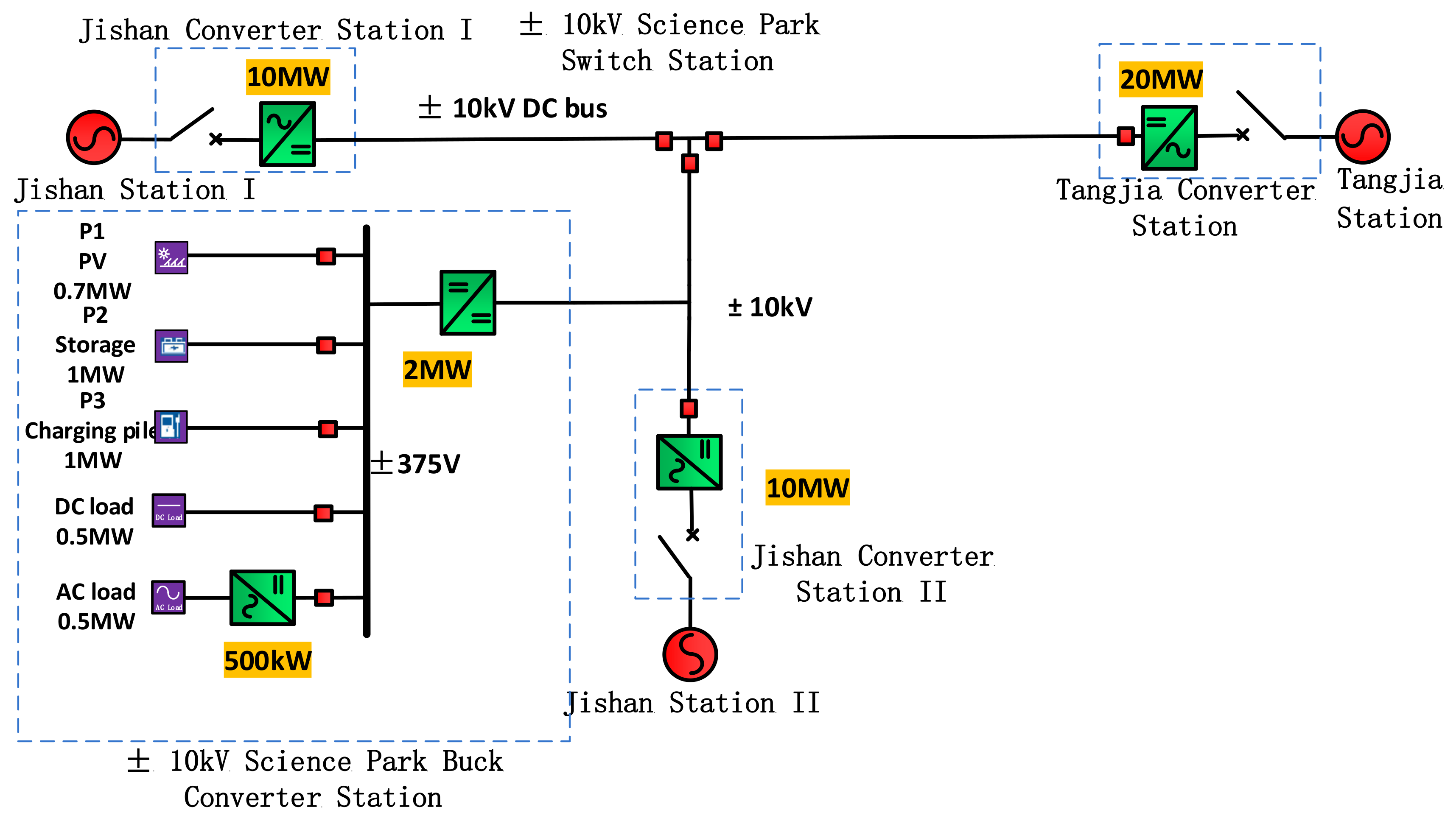
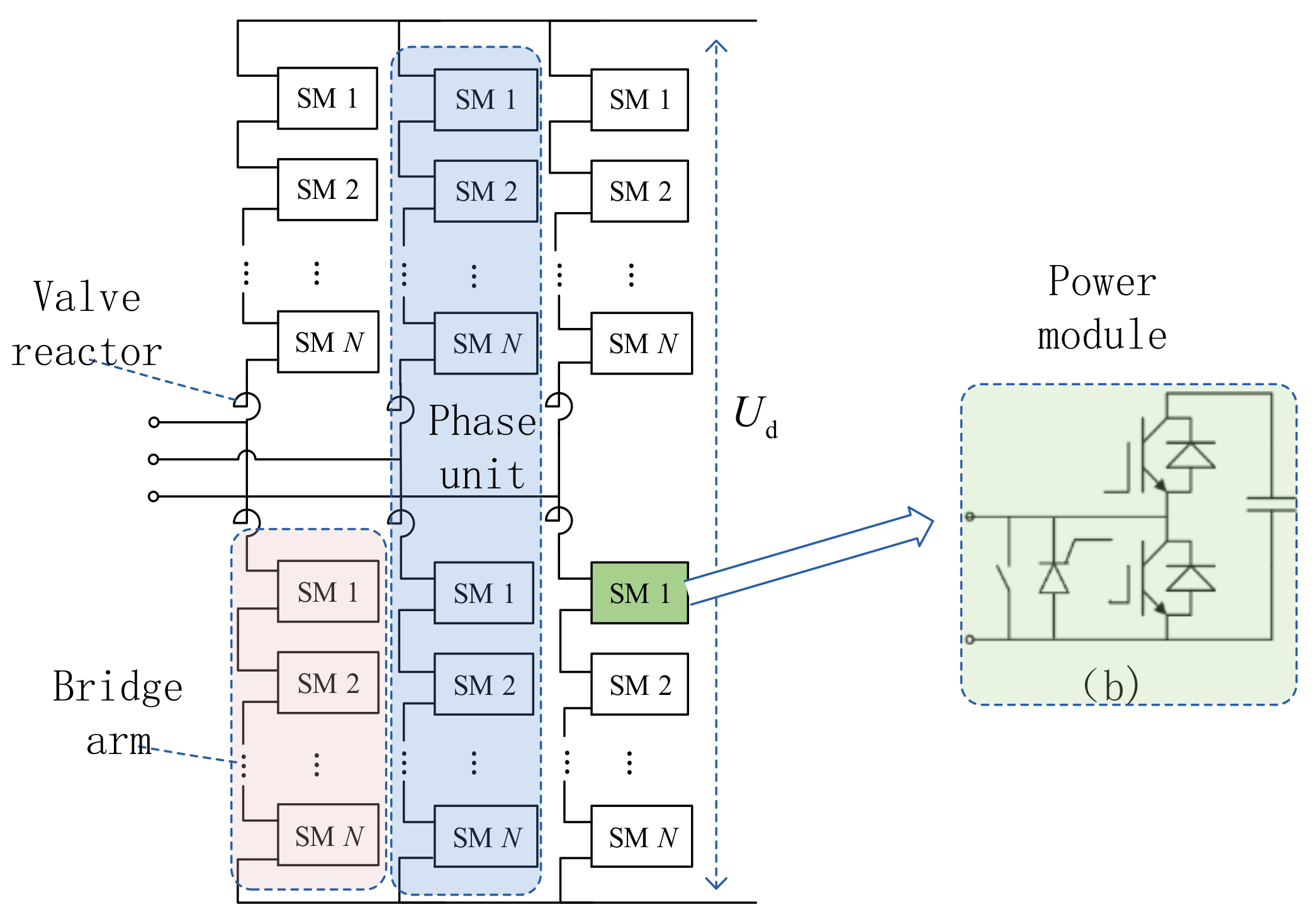
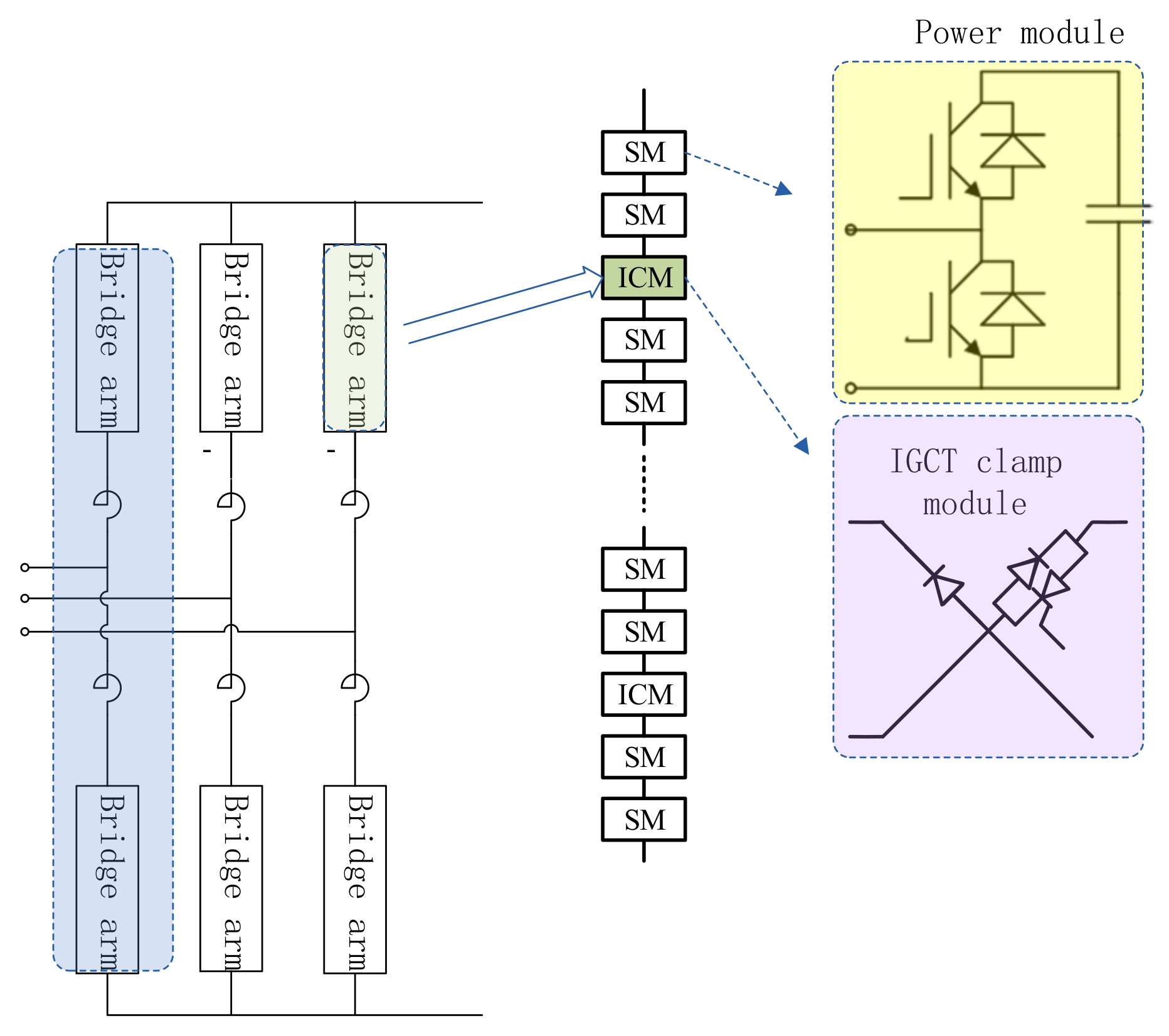

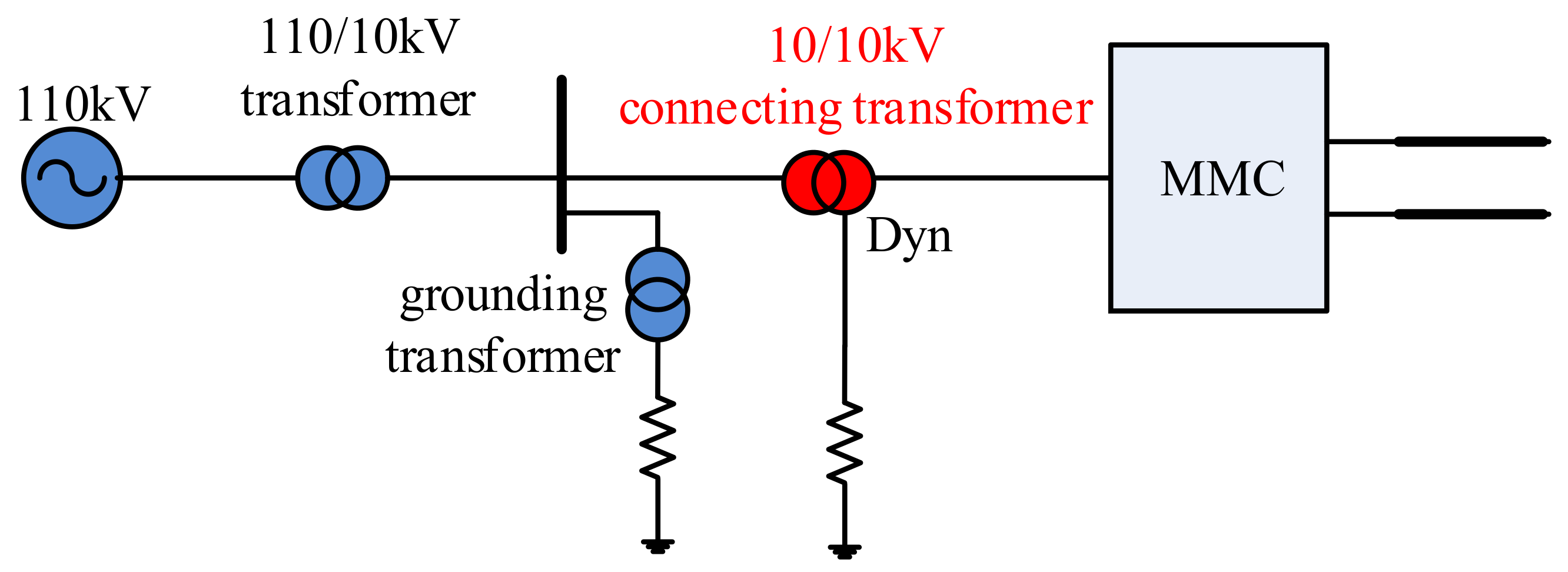
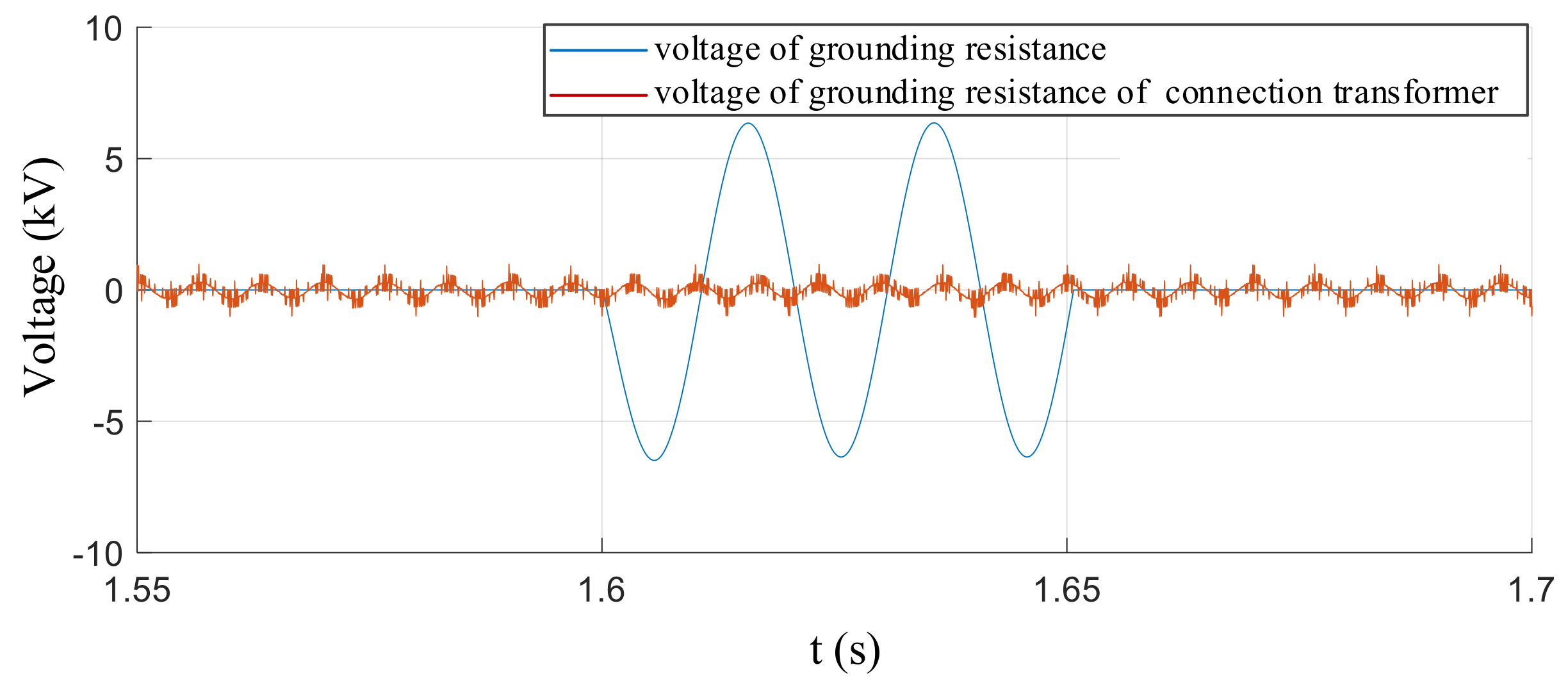
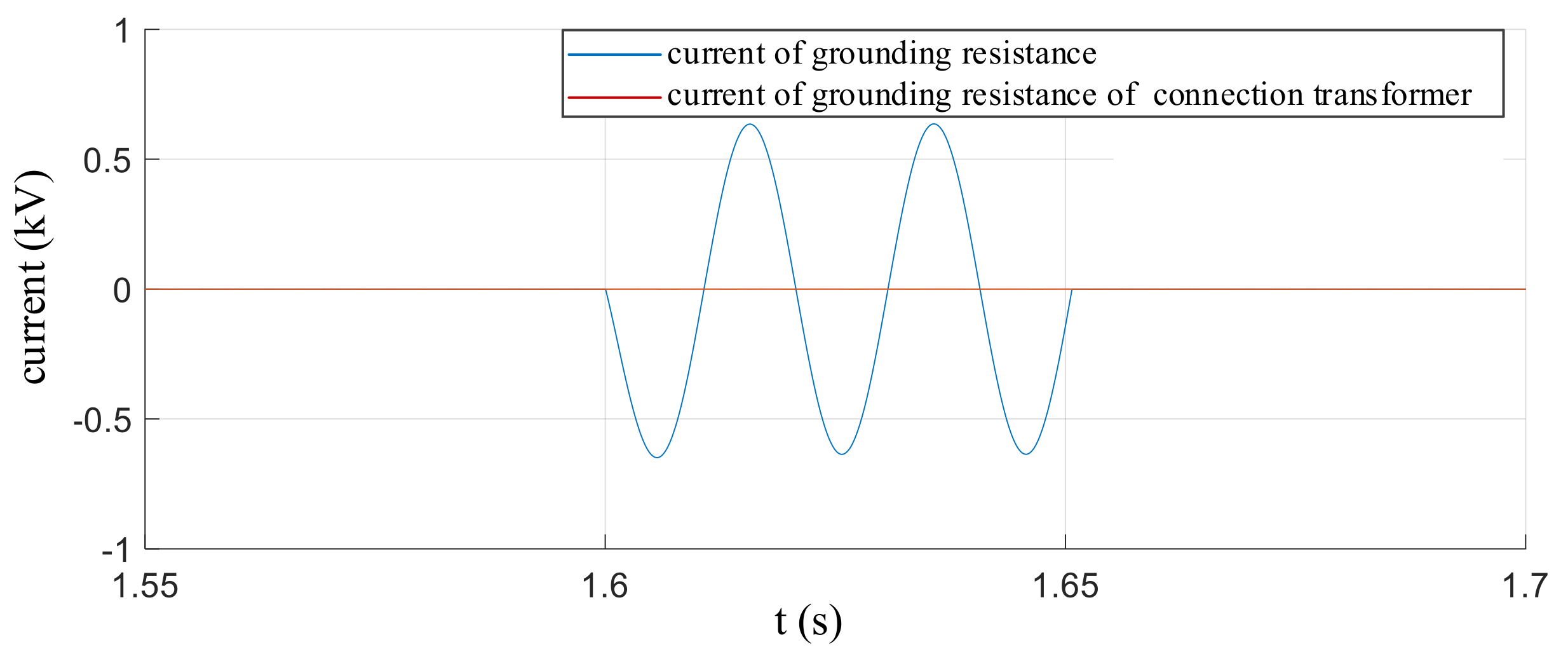
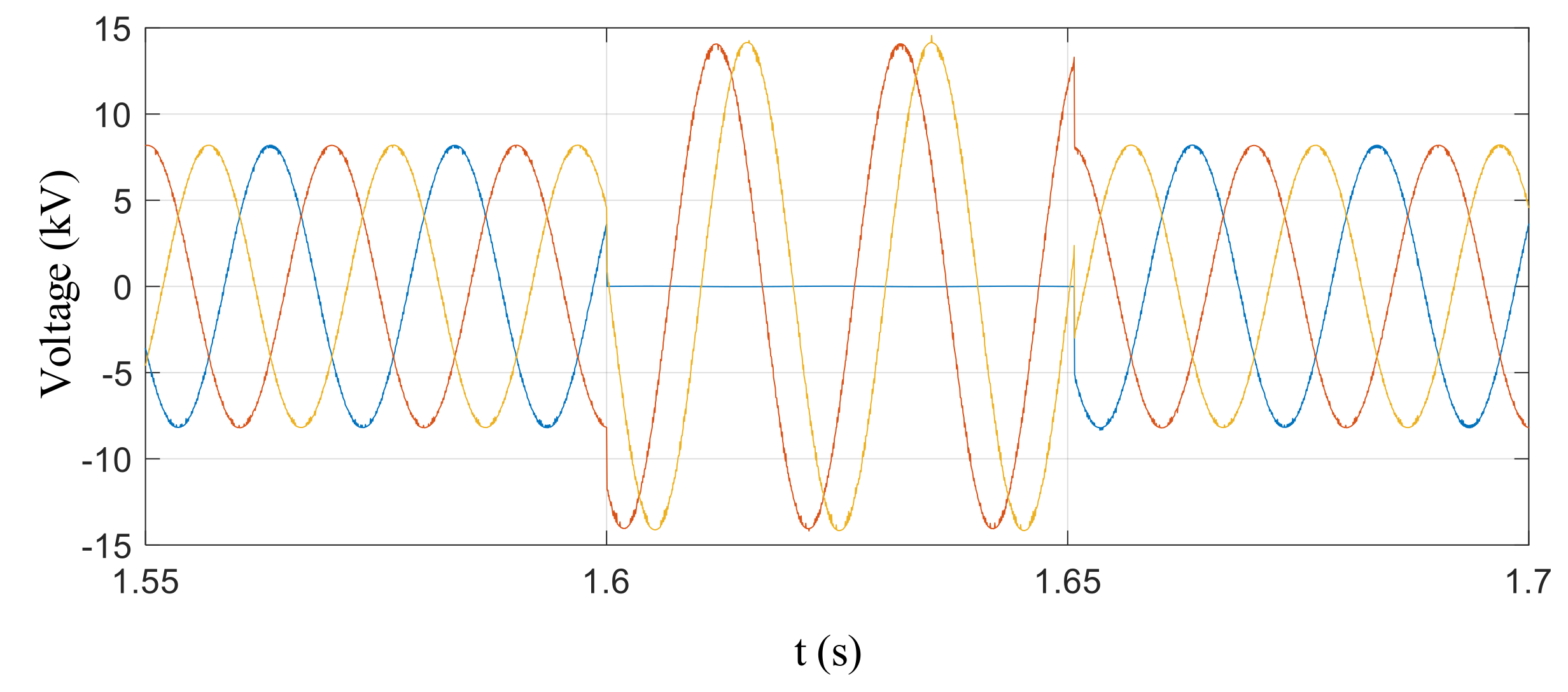
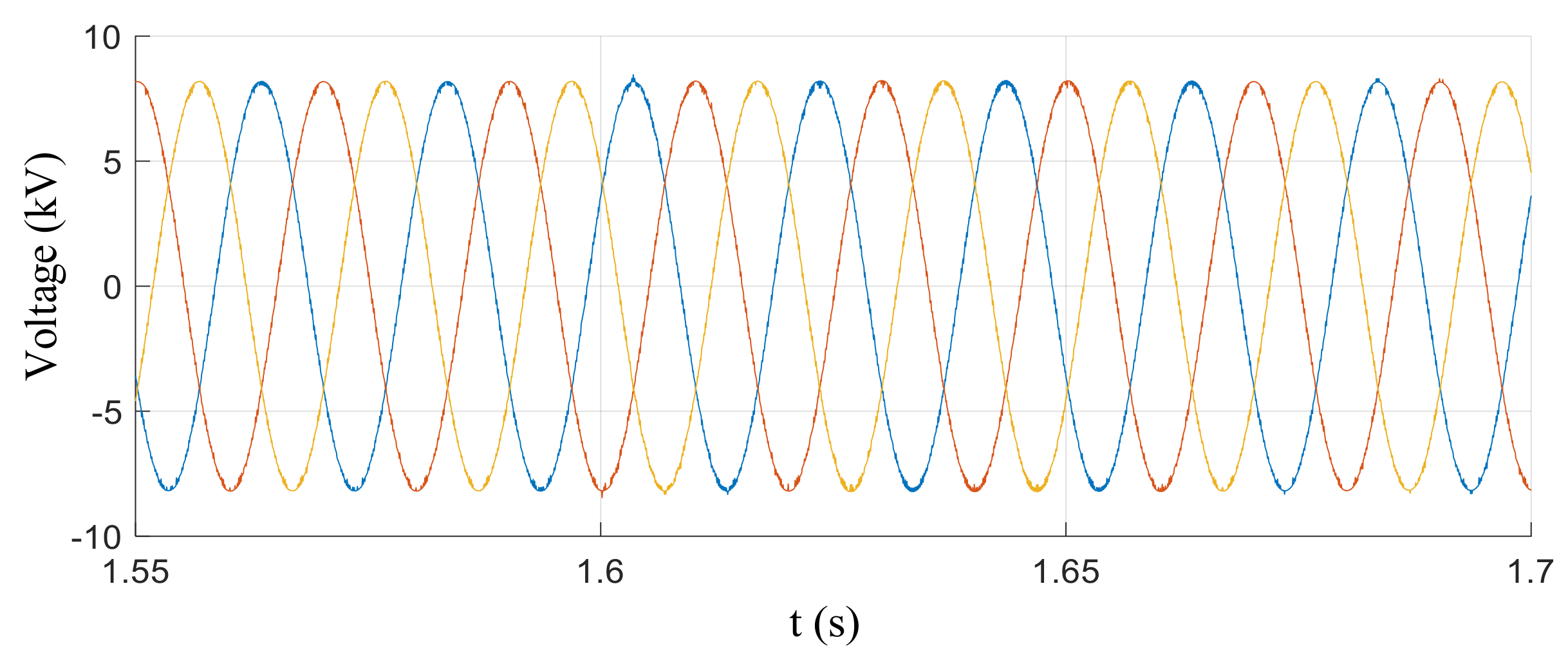

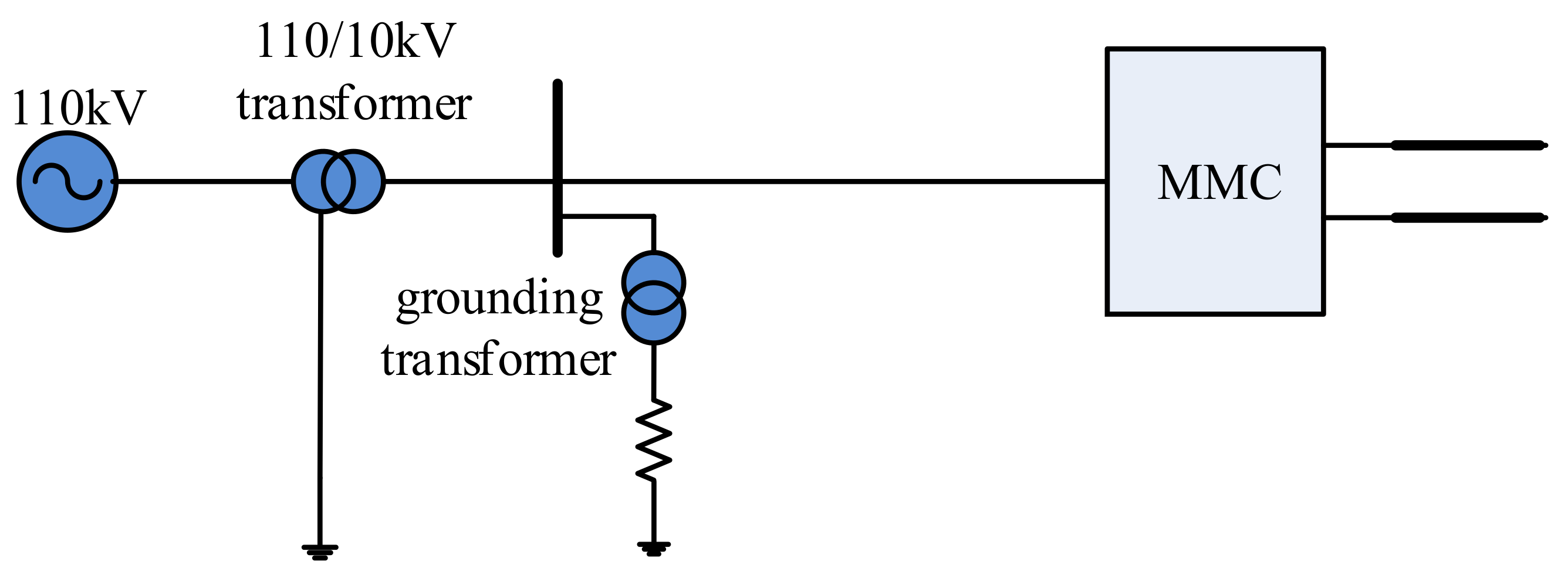
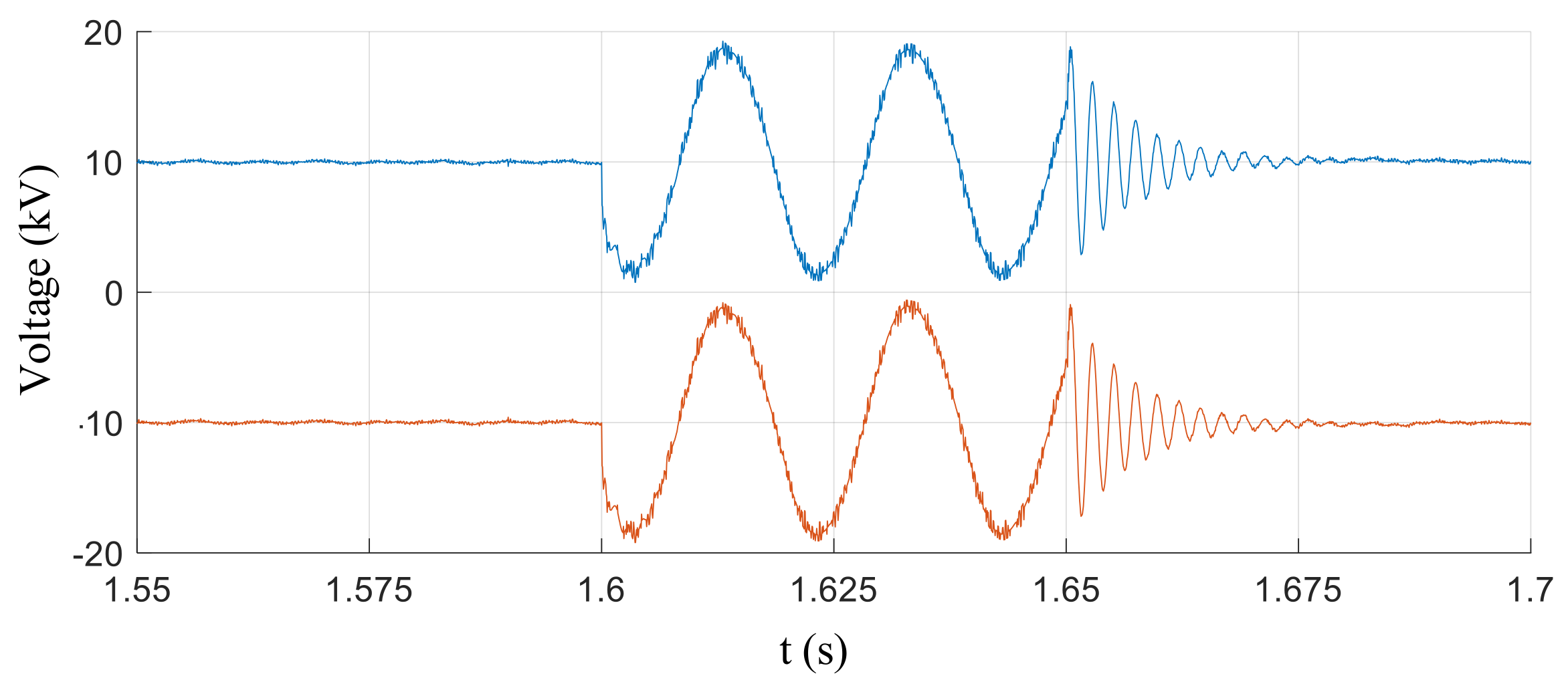
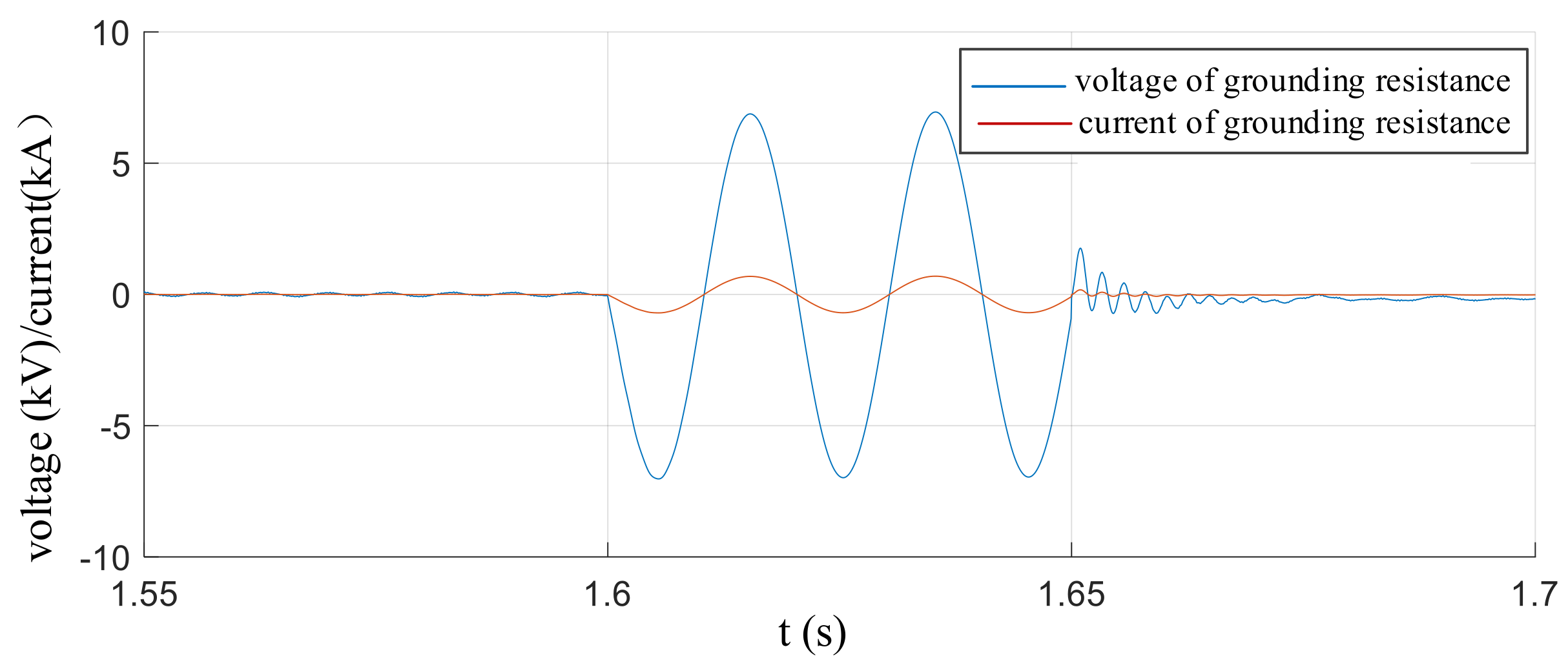
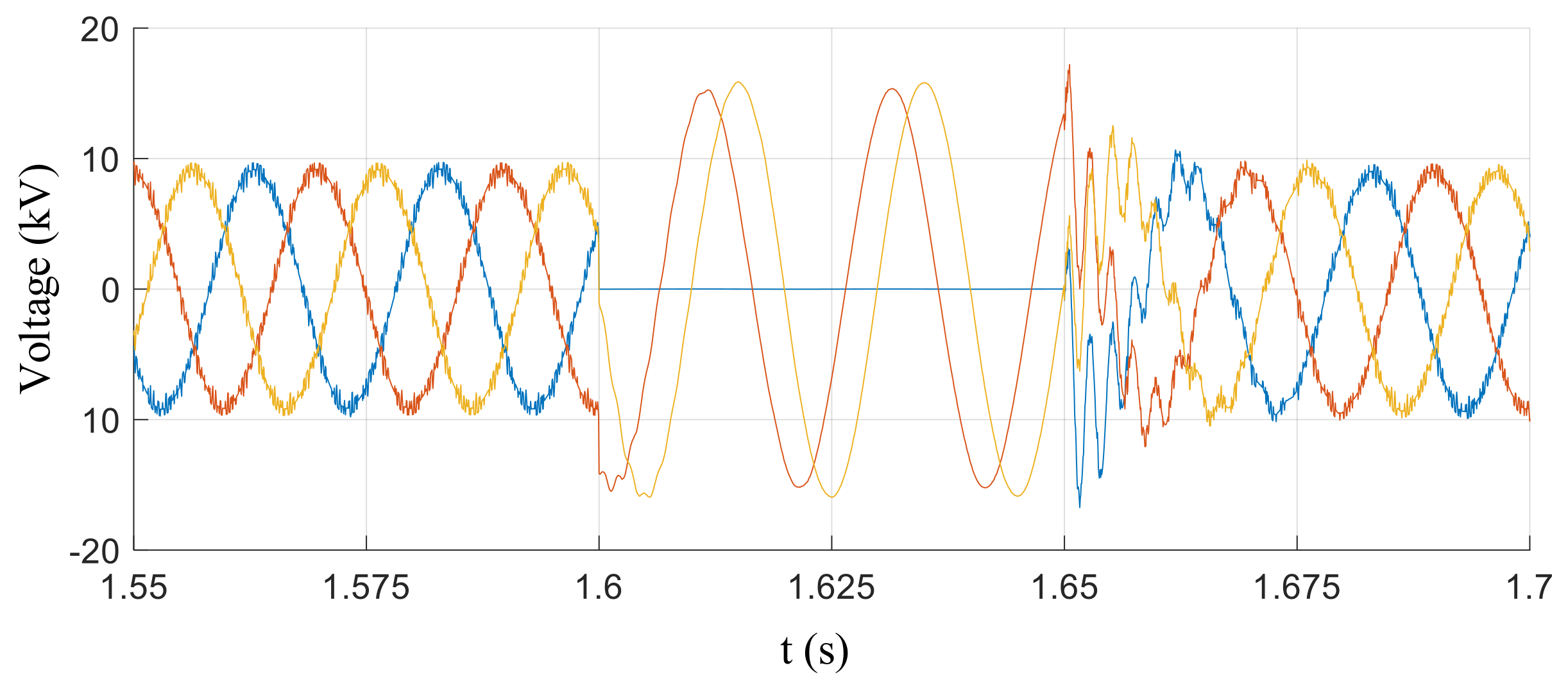
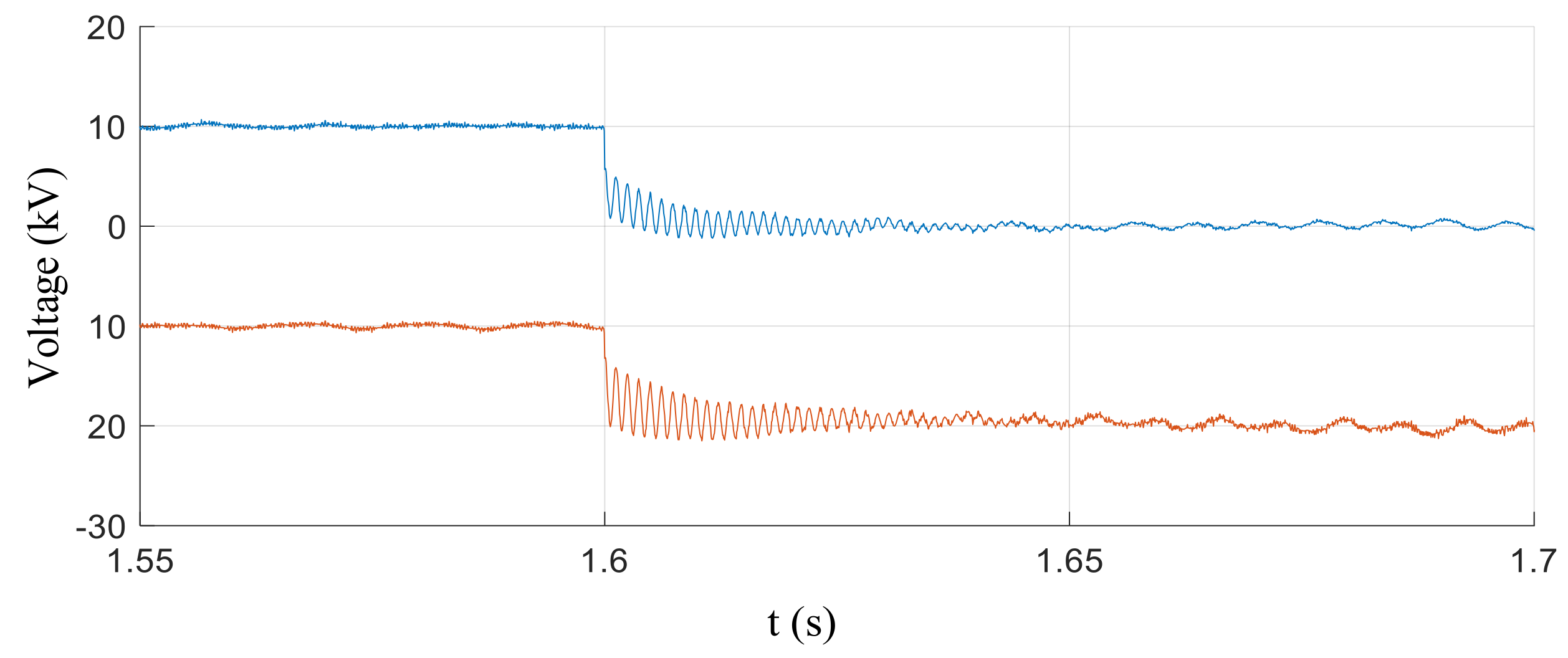
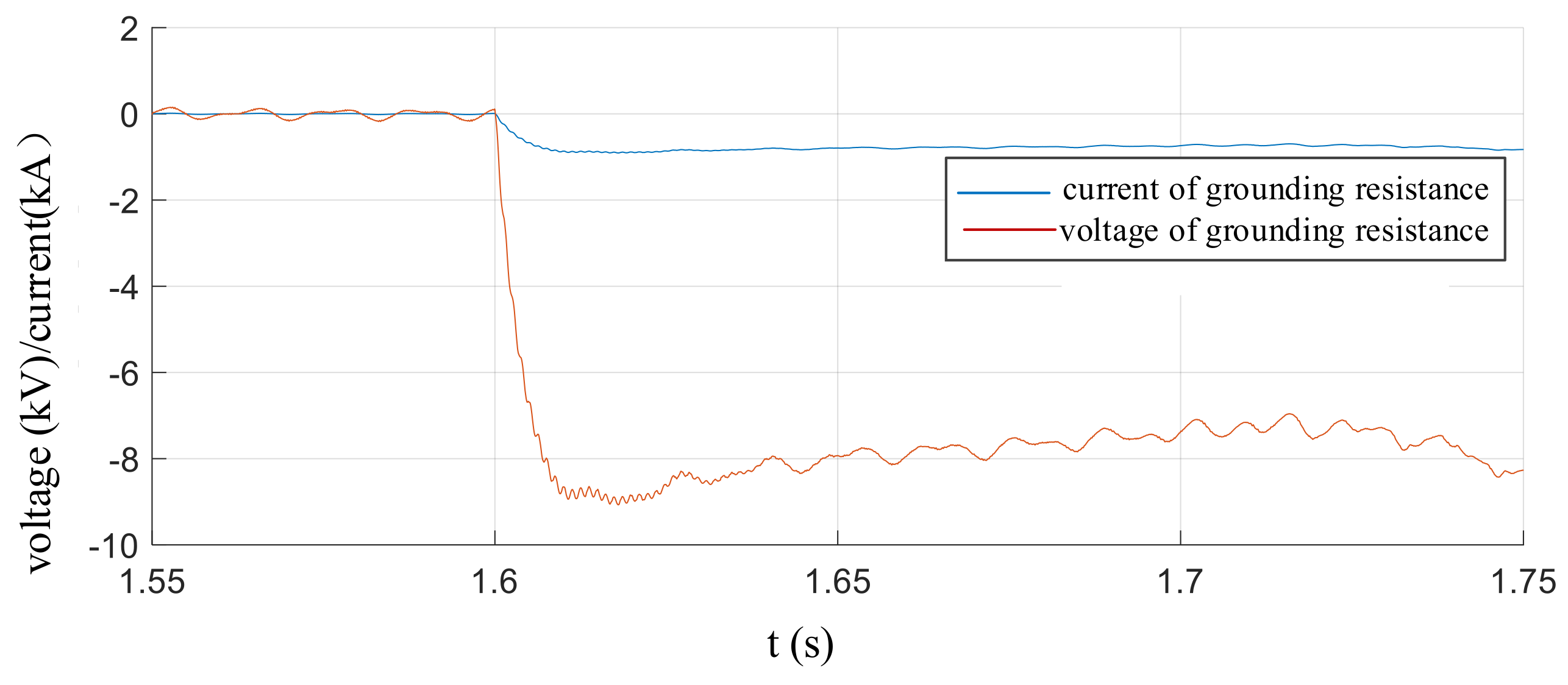

| Tangjia Station | Jishan I Station | Jishan II Station | |
|---|---|---|---|
| Rated capacity (MVA) | 20 | 10 | 10 |
| Reactive output range (Mvar) | −10~10 | −5~5 | −5~5 |
| Rated DC voltage (kV) | ±10 | ±10 | ±10 |
| Rated DC current (A) | 1000 | 500 | 500 |
| Rated AC voltage (kV) | 10.5 | 10.5 | 10.5 |
| Rated AC current (A) | 1155 | 577 | 577 |
| Rated current of bridge arm(A) | 666 | 333 | 333 |
| Voltage | Source | Storage | Load |
|---|---|---|---|
| 10 kV | Jishan I Station 10 MW | 0 | 0 |
| Jishan II Station 10 MW | |||
| Tangjia Station 20 MW | |||
| ±375 V | Photovoltaic(PV) 0.7 MW | 1 MW | 1 MW charging pile |
| 500 kW DC load | |||
| 500 kW AC load |
| Key Position | Voltage (kV) |
|---|---|
| 110 kV AC bus to ground | 90.2 |
| 10 kV AC bus to ground | 8.3 |
| Both ends of bridge-arm reactor | 1.0 |
| Both ends of bridge arm | 20.6 |
| DC reactor valve-side to ground | 10.4 |
| DC reactor line-side to ground | 10.1 |
| Both ends of DC reactor | 0.3 |
| 10 kV DC bus inter-pole | 20.7 |
| Both ends of AC system ground resistance | 0 |
| Key Position | Current (kA) |
|---|---|
| 110 kV AC bus | 0.08 |
| 10 kV AC bus | 1.68 |
| Bridge-arm reactor | 1.06 |
| Positive 10 kV DC bus | 1 |
| Negative 10 kV DC bus | 1 |
| AC system ground resistance | 0 |
| Parameter | Key Position | Single Phase-to-Ground | Three Phase-to-Ground |
|---|---|---|---|
| Overvoltage (Peak Value) | 10 kV AC bus to ground (kV) | 8.55 | 8.34 |
| Both ends of bridge-arm reactor (kV) | 4.02 | 7.61 | |
| Both ends of DC reactor (kV) | 5.39 | 8.79 | |
| 10 kV DC bus to ground (kV) | 20 | 16.21 | |
| 10 kV DC bus inter-pole (kV) | 20.21 | 23.77 | |
| Both ends of ground resistance of connection transformer (kV) | 0 | 0 | |
| Overcurrent (Peak Value) | 10 kV AC bus (kA) | 1.76 | 29.49 |
| Bridge arm-reactor (kA) | 1 | 2.63 | |
| 10 kV DC bus (kA) | 1 | 2.04 | |
| Ground resistance of connection transformer (kA) | 0 | 0 | |
| Fault point (kA) | 0.2 | 29.49 |
| Parameter | Key Position | Single-Pole Grounding Fault | Bipolar Short-Circuit Fault |
|---|---|---|---|
| Overvoltage (Peak value) | 10kV AC bus to ground (kV) | 8.47 | 8.68 |
| Both ends of bridge-arm reactor (kV) | 2.34 | 6.51 | |
| Both ends of DC reactor (kV) | 6.91 | 45.79 | |
| 10kV DC bus to ground (kV) | 27.46 | 18.87 | |
| 10kV DC bus inter-pole (kV) | 20.73 | 37.66 | |
| Both ends of ground resistance of connection transformer (kV) | 0 | 0 | |
| Overcurrent (Peak value) | 10kV AC bus (kA) | 1.65 | 1.89 |
| Bridge arm-reactor (kA) | 1.01 | 1.79 | |
| 10kV DC bus (kA) | 1 | 3.23 | |
| Ground resistance of connection transformer (kA) | 0 | 0 | |
| Fault point (kA) | 1.17 | 11.89 |
| Parameter | Key Position | Single-Ground | Three-Phase-to-Ground |
|---|---|---|---|
| Overvoltage (Peak Value) | 10 kV AC bus to ground (kV) | 14.24 | 13.67 |
| Both ends of bridge-arm reactor (kV) | 4.04 | 7.71 | |
| Both ends of DC reactor (kV) | 4.02 | 10.11 | |
| 10 kV DC bus to ground (kV) | 18.35 | 17.95 | |
| 10kV DC bus inter-pole (kV) | 20.56 | 23.20 | |
| Both ends of ground resistance of connection transformer (kV) | 6.27 | 2.13 | |
| Overcurrent (Peak Value) | 10 kV AC bus (kA) | 2.68 | 54.45 |
| Bridge arm-reactor (kA) | 1.23 | 2.25 | |
| 10 kV DC bus (kA) | 1.45 | 1.45 | |
| Ground resistance of connection transformer (kA) | 0.641 | 0.100 | |
| Fault point (kA) | 1.57 | 55.42 |
| Parameter | Key Position | Single-Pole Grounding Fault | Bipolar Short-Circuit Fault |
|---|---|---|---|
| Overvoltage (Peak value) | 10 kV AC bus to ground (kV) | 19.40 | 9.45 |
| Both ends of bridge-arm reactor (kV) | 8.06 | 14.04 | |
| Both ends of DC reactor (kV) | 5.66 | 129.67 | |
| 10 kV DC bus to ground (kV) | 24.44 | 28.77 | |
| 10 kV DC bus inter-pole (kV) | 22.53 | 56.7 | |
| Both ends of ground resistance of connection transformer (kV) | 9.04 | 0.30 | |
| Overcurrent (Peak value) | 10 kV AC bus (kA) | 2.30 | 2.08 |
| Bridge arm-reactor (kA) | 2.54 | 1.7 | |
| 10 kV DC bus (kA) | 1.89 | 3.05 | |
| ground resistance of connection transformer (kA) | 0.904 | 0.030 | |
| Fault point (kA) | 2.76 | 12.76 |
© 2019 by the authors. Licensee MDPI, Basel, Switzerland. This article is an open access article distributed under the terms and conditions of the Creative Commons Attribution (CC BY) license (http://creativecommons.org/licenses/by/4.0/).
Share and Cite
Liu, Y.; Chen, J.; Qu, L.; Yu, Z.; Nie, Z.; Zeng, R. Research on Access Mode of the Flexible DC Power Distribution System into AC System. Energies 2019, 12, 4002. https://doi.org/10.3390/en12204002
Liu Y, Chen J, Qu L, Yu Z, Nie Z, Zeng R. Research on Access Mode of the Flexible DC Power Distribution System into AC System. Energies. 2019; 12(20):4002. https://doi.org/10.3390/en12204002
Chicago/Turabian StyleLiu, Yao, Jianfu Chen, Lu Qu, Zhanqing Yu, Zipan Nie, and Rong Zeng. 2019. "Research on Access Mode of the Flexible DC Power Distribution System into AC System" Energies 12, no. 20: 4002. https://doi.org/10.3390/en12204002
APA StyleLiu, Y., Chen, J., Qu, L., Yu, Z., Nie, Z., & Zeng, R. (2019). Research on Access Mode of the Flexible DC Power Distribution System into AC System. Energies, 12(20), 4002. https://doi.org/10.3390/en12204002





